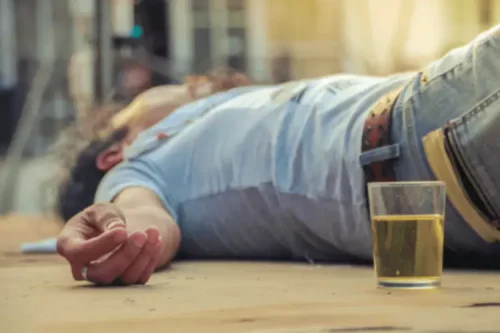Countering The Abstinence Violation Effect: Supporting Recovery Through Relapse
Content
It is known that the longer someone abuses a substance, the higher tolerance they will have for the effects it produces. This is why, after a period of abstinence, https://ecosoberhouse.com/ that person’s tolerance declines substantially, and why someone can accidentally overdose if they start to use again at the same level as before abstaining.
What are the three levels of explanation in psychology?
Marr (1982) distinguished between three levels of explanation, the what/why level (computational theory), the how level (algorithm), and the physical realization level (implementation).
Have you ever made a determination to start a new habit and have you been able to stay 100% dedicated to it through the remainder of your life? (insert cricket sound…) Of course, if you are reading this then you are still living and cannot confirm nor deny the attainment of this goal. If you are like most people, you set a goal to establish some new behavior which can be performed consistently and probably have sometimes where you fall short of your idealized expectations. Perhaps you said you would start waking up an hour earlier so you can exercise, or you’ve sworn off some specific type of food, only to find yourself having periodic success.
The Abstinence Violation Effect
At any point in time, any one of these can put someone at risk of relapsing. Another example is the urge to smoke at the times when smoking was enjoyed, such as with a coffee in the morning or when driving long distances. Although the benefits of 12-step participation may outweigh the added AVE risk, clinicians should be aware of this particular risk and take steps to counteract it.
- Recontact contracts can also be useful where it is agreed in advance what the criterion will be for a time where a gambler should recontact the therapist.
- These alcohol-related cognitions are placed in the relapse prevention model within the overlap of the tonic stable processes and the phasic fluid responses.
- More and more, behavioral health organizations are moving away from “kicking people out of treatment” if they return to substance use.
- Conversely, people with ineffective coping responses (decreased self-efficacy) which, together with the expectation that drug use will have a positive effect (i.e., positive outcome expectancies), can result in an initial lapse.
- Additionally, abstinence violation effect can affect people differently, based on different factors in their lives.
Vertava Health offers 100% confidential substance abuse assessment and treatment placement tailored to your individual needs. Contrasting this, the aforementioned negative mindsets can lead to a cycle of blame and shame. Instead of looking at the slip as an opportunity to grow and learn, a person lets it color the way they think about themselves.
How Can the Abstinence Violation Effect Hinder Recovery?
Marlatt teaches a technique called „urge surfing“ as a way to cope. „It goes up and down. You don’t try to get rid of it, but accept it and let it pass.“ People tend to think that urges will escalate infinitely if they don’t yield to them — but in fact, like a wave, they rise to a peak and then fall. The durability of the symptoms and the failure of new psychiatric syndromes to emerge in the follow‐up period is evidence that bulimia is a distinct diagnostic entity and not a variant of another underlying condition.
What is one of the first signs of cognitive decline?
Forgetting appointments and dates. Forgetting recent conversations and events. Feeling increasingly overwhelmed by making decisions and plans. Having a hard time understanding directions or instructions.
When abstinence violation occurs, individuals typically enter a state of cognitive dissonance, defined as an aversive experience resulting from the discrepancy created by having two or more simultaneous and inconsistent cognitions. Abstinence violators realize that their actions (e.g. “I drank”) do not line up with their personal goal (e.g. “I want to abstain”) and feel compelled to resolve the discrepancy. Attributions are made to try to resolve or justify the discrepancy. In this case, individuals try to explain to themselves why they violated their goal of abstinence. The abstinence violation effect refers to the negative cognitive and affective responses that an individual experiences after the return to substance abuse after a period of abstinence. These responses, both physical and psychological, can be very difficult to deal with.
Etiological Influences in Eating Disorders
The Abstinence Violation Effect was a theory developed to help combat the incidence of individuals falling into lapse and subsequent relapse by creating a more thorough understanding of the mechanisms involved in relapse. Among those mechanisms were shame, misunderstanding, and blame; individuals who feel that relapse is an indication of an inherent flaw or an entirely uncontrollable aspect of their disease feel ashamed, hopeless, and unable to combat relapse. It became the work of the individuals who identified the Abstinence Violation Effect to mitigate the negative effects of this thought process and create healthier coping mechanisms and a greater understanding of addiction and addiction recovery. The revised dynamic model of relapse also takes into account the timing and interrelatedness of risk factors, as well as provides for feedback between lower- and higher-level components of the model. For example, based on the dynamic model it is hypothesized that changes in one risk factor (e.g. negative affect) influences changes in drinking behavior and that changes in drinking also influences changes in the risk factors.
An individual who believes they’ve failed and violated their sobriety goals may begin to think that they’re not good enough to be considered a true abstainer. We at JourneyPure support our patients and recovering family members with a mixture of cutting-edge therapies and tried-and-true treatment approaches. Contact us today to find out how we can help you or a loved one reengage with an active, healthy, and sober lifestyle. There is nothing abnormal about relapse in recovery, which is why it is imperative that everyone recovering from a substance use disorder knows how to prevent relapse.
Experiential Aspects of Bulimia Nervosa
Having healthy and effective coping strategies in place to anticipate a lapse or relapse is pivotal, because the likelihood of never again lapsing into an addictive behavior is often quite low. This effect is often unintentionally amplified by the 12-Step approach. I’ve heard of AA meetings where a member with over 10 years of sobriety ends up drinking (let’s say as an attempt to cope with the loss of a loved one or other tragic event).
Our hopelessness and our instinctive desire to give up were spot-on, or else we would be happy all the time. But when we feel this way about ourselves, it somehow feels rational. Giving up on sobriety should never feel like a justified response to vulnerability. Looking back does have its benefits in that it helps us identify weaknesses in our program. The problem is that abstinence violation effect magnifies these weaknesses and prevents us from seeking solutions. Our first instinct should be to figure out a relapse prevention plan that addresses the faults we have identified. This is an important measure, but it doesn’t do much for relapse prevention if we don’t forge a plan to deal with these disturbances when they arise.
So long as an individual maintains a perceived sense of self-control, he/she has a better chance at evading further lapses. AVE has been studied and supported for the cessation of sex offenses, heroin, marijuana, and other illicit drug use. Starting from the point of confronting and recognizing a high-risk situation, Marlatt’s model illustrates that the individual will deal with the situation with either an effective or ineffective coping response. Effective coping skills can lead to increased self-efficacy, and a decreased probability of a lapse. However, if one lacks skills, then the model predicts a decrease in self-efficacy and an increase in positive outcome expectancies for the effects of using the substance. This is a likely predecessor of giving into temptation in the initial use of a substance. Most people who try to change problem behaviors — whether it’s overeating, overspending or smoking cigarettes — will slip at least once.
- Dieting behaviors may tax the adaptive capacities of serotonergic pathways.
- We must learn to recognize this if we wish to stay on the right track.
- A verbal or written contract will increase the chance that gamblers will recontact at an appropriate stage and therefore minimise the likelihood of a full blown relapse.
- Relapse rates for methamphetamine use disorders were estimated to be 52.2 percent.
- This approach would be applicable to recovered depressed patients and would serve as a means of preventing relapse.
- Although there may be practical reasons for your client to choose abstinence as a goal (e.g., being on probation), it is inaccurate to characterize abstinence-based recovery as the only path to wellness.
This viewpoint that the deviation is a total failure is then used as a further justification to continue using or doing the addictive behavior. I have had clients that expressed after having one sip of a drink, they felt so badly and shameful for failing that this was the permission giving thought that getting drunk wouldn’t be any worse. Feelings of personal failure can lead to ongoing use of the substance.
Prolonged use of a substance causes a level or physical tolerance but after a period of abstinence that tolerance declines substantially. This is why many individuals what is abstinence violation effect who have been abstinent (or „clean“) for awhile accidentally overdose by starting to use again at the same level of use they were at before their abstinence period.
The most important thing to remember when experiencing challenges in recovery is to accept them and find healthy ways to get past them so that the recovery can continue. For some, this process is difficult to grasp, and this difficulty can lead to major setbacks, including relapse. In addition to this, booster sessions over at least a 12 month period are advisable to ensure that a safety net is available since gamblers are renown for not recontacting sufficiently hastily when difficulties arise. Recontact contracts can also be useful where it is agreed in advance what the criterion will be for a time where a gambler should recontact the therapist. The guiding strategy here is to ensure that gamblers learn to cope with minor setbacks on their own but are able to recognise more major setbacks before they become fully blown relapses. A verbal or written contract will increase the chance that gamblers will recontact at an appropriate stage and therefore minimise the likelihood of a full blown relapse. Effect and ensures that patients no longer adhere to the “one drink, one drunk” mentality which leaves them at risk for relapse.
Writing a Goodbye Letter to Alcohol Purpose Get Support

But I am happy to say both my daughter and I are now sober, and our family has become much different as a result. It is truly a miracle I am thankful for, each and every day. Like I said already, one of the things that gave me a sense of comfort was writing a goodbye letter to addiction. I gathered up all the pain, trauma, and hopelessness and let it all out through this letter. Addiction was the hardest relationship that I ever left behind, but it was the greatest thing I ever did. There is no right or wrong time for this experience.
From Addiction to Recovery: Leigh Ann Minter
Please know that we are all ready to support you in your recovery journey. We are committed to helping you find the resources and treatment you need, whether it’s counseling, therapy, or a rehabilitation program. You are not alone in this, and we are willing to do whatever it takes to see you succeed.
Step Five: Commitment to Change for the Better
Even when I hated what I lie my life was, you were there to share the secret with me. And even when I knew my life was in pieces, and I would stare sadly at my shaking hands, it was you that made me see the beauty in those pieces. I would feel wrong if something prevented me from being with you – I turned on people who tried to take you away. I wanted your security, your comfort, your safety. I found sneakier ways of seeing you; my schemes became more sophisticated. Nothing was going to stop us being together – you were the only one who truly made me feel better.
#5. A Letter Addressing Failed Attempts at Recovery
I knew things were getting serious when my own body rebelled against me. I hadn’t really noticed how dependent I had become on you because I spent every day in bed anyway. I don’t know when I stopped getting up in the morning. I don’t remember making that decision – it was just something that happened. It was easier for us to stay in bed together and not face the world. Eventually you became more important to me than anything and anyone else.

You might think you have everyone fooled, but I have news for you, Alcohol – WE ARE ON TO YOU! There is a movement of people who are rising up above your influence and we are saying we want more for our lives. Oh dear friendAlcohol, what a long, weary road we have traveled together. When I first met you at the ripe age of 15, I had no idea what an impact you would make https://ecosoberhouse.com/article/top-10-substance-abuse-group-activities/ on my life – and not the good kind, unfortunately. Connection is a story of trauma, and the overcoming of trauma. A story that resonates in today’s world of the oppressed and their oppressors.

- But it’s also fine to admit that alcohol destroyed your life and was a thief of your time and energy.
- The goal is to create a profound emotional connection and encourage your husband to seek help and take steps toward recovery.
- It’s a sincere acknowledgment of the challenges and a declaration of determination to move toward a life of resilience and fulfillment.
- She is filled with joy and gratitude and takes things one day at a time.
- I hope this letter finds you well, and I want to begin by saying that I love you and care deeply about our family.
It feels like the alcohol has become your true companion, and I’m left on the sidelines, wondering if I will ever have my husband back. I pray that you find the strength within yourself to make the necessary changes, and I am hopeful that we can rebuild our lives together. However, the ball is now in your court, and your actions will determine the course of our future.

#2. A Letter Establishing Boundaries for Healing

Please, my love, let us work together to build a healthier and happier future for ourselves and our family. Your health is too important to be compromised, and I will be here every step of the way to support and love you through this journey to recovery. First and foremost, I want to make it crystal clear that I cannot continue down the path of your alcoholism with you.
Binge Drinking Isn’t Lucky: Sobering St. Patrick’s Day Statistics 2024
- I found sneakier ways of seeing you; my schemes became more sophisticated.
- I am so grateful to have had the lessons both these experiences taught me, but am very glad that both are now part of my past.
- But I am prepared to make that sacrifice if it means you have a chance at a better, healthier life.
- I never blamed you for it at the time, but really I had ended up stuck in a life I didn’t want because of you.
You don’t get to claim us as “Alcohol-ics,” anymore. We are changing our names during this divorce back to who we were goodbye letter to alcohol examples before you moved in on our lives. It’s a clean break and we won’t be taking your name along with us. So, if you’ve been wondering why I said goodbye to you for good, it was because I began to resent you and then quickly fell out of love with you.
I loved you too much to only see you now and then, to cut short our acquaintance. I paced around feeling lost and unsure of what to do. And then I remembered how comforting it could be to have you around. How you made me feel as if I was wrapped in a delightful bubble, and I wanted you.
15 Tips To Stop Drinking Alcohol
Content
In general, the longer and more intense the alcohol use, the longer and more intense the treatment you’ll need. But regardless of the treatment program’s length in weeks or months, long-term follow-up care is crucial to your recovery.
Overcoming an addiction to alcohol can be a long and bumpy road. If you’re ready to stop drinking and willing to get the support you need, you can recover from alcoholism and alcohol abuse—no matter how heavy your drinking or how powerless you feel. And you don’t have to wait until you hit rock bottom; you can make a change at any time. Whether you want to quit drinking altogether or cut down to healthier levels, these guidelines can help you get started on the road to recovery today. You can benefit from our inpatient and outpatient medical treatment options. Our medical professionals aim to improve the lives of people struggling with substance use or mental health disorders. Don’t quit alone Perhaps because of guilt, shame, or remorse, you feel like you need to stop drinking all on your own.
A quick look at 10 of the best apps to stop drinking alcohol
However, this approach is not going to work for everyone, he said, like those with alcohol-use disorder. Reducing or stopping drinking alcohol after drinking heavily for a period can also cause mental and physical effects like nausea, insomnia, and anxiety, according to WebMD. While these findings are a concern, there are practical ways to cut back on drinking, such as planning break days and switching to mocktails or nonalcoholic beers. But most people have a hard time discerning when they’ve gone beyond moderate drinking and should consider cutting back, according to Koob. MHA Screening is an educational program intended to help inform people about options they have in getting help for mental health issues.
Where do you get liver pain?
Pain in your liver itself can feel like a dull throbbing pain or a stabbing sensation in your right upper abdomen just under your ribs. General abdominal pain and discomfort can also be related to swelling from fluid retention and enlargement of your spleen and liver caused by cirrhosis.
The app uses hypnotherapy, relaxation, visualization, and positive suggestion. Please note that the writer of this article has not tried these products. All information presented is purely research-based and correct at the time of publication. We include products we think are useful for our readers.
Evaluating the costs and benefits of drinking
The study also showed that there was no single treatment approach that was right for every individual. Professional treatment for an alcohol use disorder can involve outpatient therapy, residential treatment, or inpatient hospitalization. The level of care you need often depends on the severity of your condition. Quitting early not only improves your chances of success—it can also reduce the need for higher levels of care. It starts by telling you how Bette’s dead body was discovered, several weeks after dying of alcoholism, surrounded by rubbish in a home that was falling apart. Then it lists all of the ways her poor body had gradually broken down due to her addiction. It definitely feels like there’s some kind of psychologically soothing effect of cracking open that booze-free beer or popping that ‘Nosecco’ cork.
- For instance, if you consume five glasses of wine daily, consider reducing your intake to four glasses for several days and then reducing it to three.
- The sudden lack of alcohol in your system can send your body into withdrawal, resulting in various symptoms.
- Put a sticky note in places where you know you’ll need that extra reminder.
- If you wish you could change your mindset so alcohol doesn’t have a hold over you anymore, I urge you follow Allen Carr’s Easyway to Control Alcohol.
- Effects of alcohol can influence your life in many ways, ways in which you may be afraid to admit to yourself, let alone anyone else.
After choosing a goal, the Coach.me community can help keep people motivated — a person can even hire one of the app’s coaches. Sobriety Counter is an app that aims to gamify a person’s stop drinking journey. The dashboard shows people how much money they have saved by not drinking. People can also set up a treat as a goal with a personal image, and the app will show them the duration until they reach their target.
Keep a journal of your drinking habits
The whole process is flexible, and can be conducted from the comfort of home. If you’re ready to change your relationship with alcohol, get in touch with us today, or learn more about how it works. If you begin to experience severe alcohol withdrawal symptoms, you are quitting too quickly. Continue drinking at your most recent safe level for one more week, and then reduce again. Consider reducing your weekly consumption by 5 percent instead of 10 percent. When your daily alcohol consumption is less than 10 units, you can attempt to quit drinking. This is one of the most important tips for quitting drinking.
Instead of criticizing yourself for having a hard time or slipping up and having a drink, remember that no one’s perfect. What matters most is your ability to maintain an open, curious outlook as you learn How to Stop Drinking what does and doesn’t work for you. Maybe you’ve never had any interest in logging your innermost thoughts, but journaling can be a great tool to track your feelings as you work on quitting alcohol.
Set goals.
Focus on activities like working out, prioritizing self-care and wellness, and find a new hobby as you step into a healthier lifestyle. Medical News Today has strict sourcing guidelines and draws only from peer-reviewed studies, academic research institutions, and medical journals and associations. We link primary sources — including studies, scientific references, and statistics — within each article and also list them in the resources section at the bottom of our articles.
Drew Barrymore On ‚Liberating‘ Decision to Stop Drinking Alcohol – Shape Magazine
Drew Barrymore On ‚Liberating‘ Decision to Stop Drinking Alcohol.
Posted: Mon, 28 Nov 2022 08:00:00 GMT [source]
Relapse prevention PMC

Relapse poses a fundamental barrier to the treatment of addictive behaviors by representing the modal outcome of behavior change efforts [1-3]. For instance, twelve-month relapse rates following alcohol or tobacco cessation attempts generally range from 80-95% [1,4] and evidence suggests comparable relapse trajectories across various classes of substance use [1,5,6]. Preventing relapse or minimizing its extent is therefore a prerequisite for any attempt to facilitate successful, long-term changes in addictive behaviors.

Continued empirical evaluation of the RP model
The RP model also incorporates numerous specific and global intervention strategies that allow therapist and client to address each step of the relapse process. Specific interventions include identifying specific high-risk situations for each client and enhancing the client’s skills for coping with those situations, increasing the client’s self-efficacy, eliminating myths regarding alcohol’s effects, managing lapses, and restructuring the client’s perceptions of the relapse process. Global strategies comprise balancing the client’s lifestyle and helping him or her develop positive addictions, employing stimulus control techniques https://ecosoberhouse.com/ and urge-management techniques, and developing relapse road maps. A number of studies have examined psychosocial risk reduction interventions for individuals with high-risk drug use, especially people who inject drugs. In contrast to the holistic approach of harm reduction psychotherapy, risk reduction interventions are generally designed to target specific HIV risk behaviors (e.g., injection or sexual risk behaviors) without directly addressing mechanisms of SUD, and thus are quite limited in scope. However, these interventions also typically lack an abstinence focus and sometimes result in reductions in drug use.
- Treatment in this component involves describing the AVE, and working with the client to learn alternative coping skills for when a lapse occurs, such that a relapse is prevented.
- Additionally, individuals may engage in cognitive distortions or negative self-talk, such as believing that the relapse is evidence of personal weakness.
- The RP model proposes that at the cessation of a habit, a client feels self-efficacious with regard to the unwanted behaviour and that this perception of self-efficacy stems from learned and practiced skills3.
- For example, it has been shown that self-efficacy for abstinence can be manipulated [137].
- A basic assumption is that relapse events are immediately preceded by a high-risk situation, broadly defined as any context that confers vulnerability for engaging in the target behavior.
- Full-text articles were independently evaluated for inclusion and discrepancies resolved through discussion with the third author.
- Rather than labeling oneself as a failure, weak, or a loser, recognizing the effort and progress made before the lapse can provide a more balanced perspective.
Relapse prevention for addictive behaviors
Other studies have similarly found that relationships between daily events and/or mood and drinking can vary based on intraindividual or situational factors [73], suggesting dynamic interplay between these influences. Self-efficacy (SE), the perceived ability to enact a given behavior in a specified abstinence violation effect context [26], is a principal determinant of health behavior according to social-cognitive theories. Although SE is proposed as a fluctuating and dynamic construct [26], most studies rely on static measures of SE, preventing evaluation of within-person changes over time or contexts [43].
Models of nonabstinence psychosocial treatment for SUD
Given the rapid growth in this area, we allocate a portion of this review to discussing initial evidence for genetic associations with relapse. Specifically, we focus on recent, representative findings from studies evaluating candidate single nucleotide polymorphisms (SNPs) as moderators of response to substance use interventions. It is important to note that these studies were not designed to evaluate specific components of the RP model, nor do these studies explicitly espouse the RP model.
Ideally, assessments of coping, interpersonal stress, self-efficacy, craving, mood, and other proximal factors could be collected multiple times per day over the course of several months, and combined with a thorough pre-treatment assessment battery of distal risk factors. Future research with a data set that includes multiple measures of risk factors over multiple days could also take advantage of innovative modeling tools that were designed for estimating nonlinear time-varying dynamics [125]. In addition to these areas, which already have initial empirical data, we predict that we could learn significantly more about the relapse process using experimental manipulation to test specific aspects of the cognitive-behavioral model of relapse. For example, it has been shown that self-efficacy for abstinence can be manipulated [137]. Thus, one could test whether increasing self-efficacy in an experimental design is related to better treatment outcomes. Similarly, self-regulation ability, outcome expectancies, and the abstinence violation effect could all be experimentally manipulated, which could eventually lead to further refinements of RP strategies.
- Temptations neither provoked an AVE nor enhanced self-efficacy in either lapsers or maintainers.
- Twenty-one of the 27 studies were RCTs/quasi-experiments; five were nonrandomized and one was purely economic.
- One study found that momentary coping reduced urges among smokers, suggesting a possible mechanism [76].
Relapse has been variously defined, depending on theoretical orientation, treatment goals, cultural context, and target substance (Miller, 1996; White, 2007). It is, however, most commonly used to refer to a resumption of substance-use behavior after a period of abstinence from substances (Miller, 1996). The term relapse may be used to describe a prolonged return to substance use, whereas lapsemay be used to describe discrete,… Two publications, Cognitive Behavioral Coping Skills Training for Alcohol Dependence (Kadden et al., 1994; Monti, Kadden, Rohsenow, Cooney, & Abrams, 2002) and Cognitive Behavioral Therapy for Cocaine Addiction (Carroll, 1998), are based on the RP model and techniques.
- Her work focuses on implicit (i.e. nonconscious or automatic) cognitive processes that contribute to the development and maintenance of maladaptive behavior and psychopathology.
- John’s goal is to monitor every department to ensure proper policies and procedures are in place and client care is carried out effortlessly.
- Recent reviews provide a convincing rationale for the putative role of implicit processes in addictive behaviors and relapse [54,56,57].
- Encouragement and understanding from friends, family, or support groups can help individuals overcome the negative emotional aftermath of the AVE.
Medical Director, Board Certified in Addiction Medicine

These individuals also experience negative emotions similar to those experienced by the abstinence violators and may also drink more to cope with these negative emotions. In a similar fashion, the nature of these attributions determines whether the violation will lead to full-blown relapse. J.F.K. has received funding from the US National Institutes of Health and the US Veterans Health Administration to conduct research into AUDs, comorbidities, treatment response and mechanisms of behavior change in AA and Self-Management and Recovery Training (SMART). Has received funding from the US National Institutes of Health and US Veterans Health Administration to evaluate a range of treatment and mutual-help organizations focused on alcohol and other drugs. If people with AUD are opposed to attending AA, despite the strong evidence for its potential to aid recovery, clinicians might consider linkage to alternative mutual-help organizations as they may confer benefits at similar levels of engagement.

About 13 studies included a bioassay (e.g. breathalyzer, saliva, urinalysis and blood); 13 did not. Due to the time during which data collection was conducted for the included studies, newer bioassays such as phosphatidylethanol (PetH) and ethyl glucuronide (EtG) were not available. John’s key responsibilities include maintaining the day-to-day operations from both a clinical and housing perspective. John’s goal is to monitor every department to ensure proper policies and procedures are in place and client care is carried out effortlessly. John joined Amethyst as a behavioral health technician where he quickly developed strong personal relationships with the clients through support and guidance.

Strengthening coping skills is a goal of virtually all cognitive-behavioral interventions for substance use [75]. One study [76] found that momentary coping differentiated smoking lapses from temptations, such that coping responses were reported in 91% of successful resists vs. 24% of lapses. Shiffman and colleagues [68] found that restorative coping following a smoking lapse decreased the likelihood of a second lapse the same day. One study found that momentary coping reduced urges among smokers, suggesting a possible mechanism [76]. Some studies find that the number of coping responses is more predictive of lapses than the specific type of coping used [76,77].


